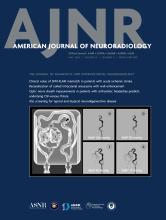Case of the Week
Section Editors: Matylda Machnowska1 and Anvita Pauranik2
1University of Toronto, Toronto, Ontario, Canada
2BC Children's Hospital, University of British Columbia, Vancouver, British Columbia, Canada
Sign up to receive an email alert when a new Case of the Week is posted.
March 30, 2023
Autoimmune Glial Fibrillary Acidic Protein Astrocytopathy
Background:
- Glial fibrillary acidic protein (GFAP) astrocytopathy is a rare but probably underdiagnosed autoimmune-related disease that affects the CNS, first described in 2016.1 Antibodies target the glial fibrillary acidic protein, which is an intermediate filament expressed by astrocytes. Although the origin of this disease is unknown, up to 20% of cases occur as a paraneoplastic syndrome (benign or malignant neoplasm).
Clinical Presentation:
- Most patients present with an acute or subacute onset of meningo-encephalo-myelitis, with the main symptoms being headache, encephalopathy, involuntary movements, ataxia, optic papillitis, and myelitis. Early flu-like symptoms are often identified.
Key Diagnostic Features:
- Diagnosis mainly relies on the detection of GFAP-IgG in CSF, along with imaging. The most striking imaging findings include:
- Brain: perivascular enhancement pattern (linear radial periventricular enhancement), T2- and FLAIR-hyperintensities in the supratentorial white matter, basal ganglia, and thalami
- Spinal cord: longitudinally extensive “hazy” T2-hyperintensities, “speckle” intramedullary enhancement, periependymal and leptomeningeal enhancement
Differential Diagnoses:
- NMOSD and MOGAD: both entities can show similar spinal cord imaging findings as in GFAP astrocytopathy. However, supratentorial linear radial periventricular enhancement is uncommon in these diseases. Anti-aquaporin 4 and anti-MOG IgG are helpful when positive.
- CLIPPERS: perivascular enhancement predominantly involves brainstem and cerebellum; supratentorial structures are usually spared.
- CNS endovascular lymphoma: perivascular enhancement is accompanied by areas of restricted diffusion (cerebral infarcts) and hemorrhagic lesions.
- Infectious meningo-encephalo-myeliti: CSF analysis is the key.
Treatment:
- Most patients respond well to corticosteroids (if necessary, IV immunoglobulin therapy and/or plasma exchange). In relapsing and chronic forms, treatment may include immunosuppressors. In paraneoplastic forms, treatment may require removal of the tumor.






